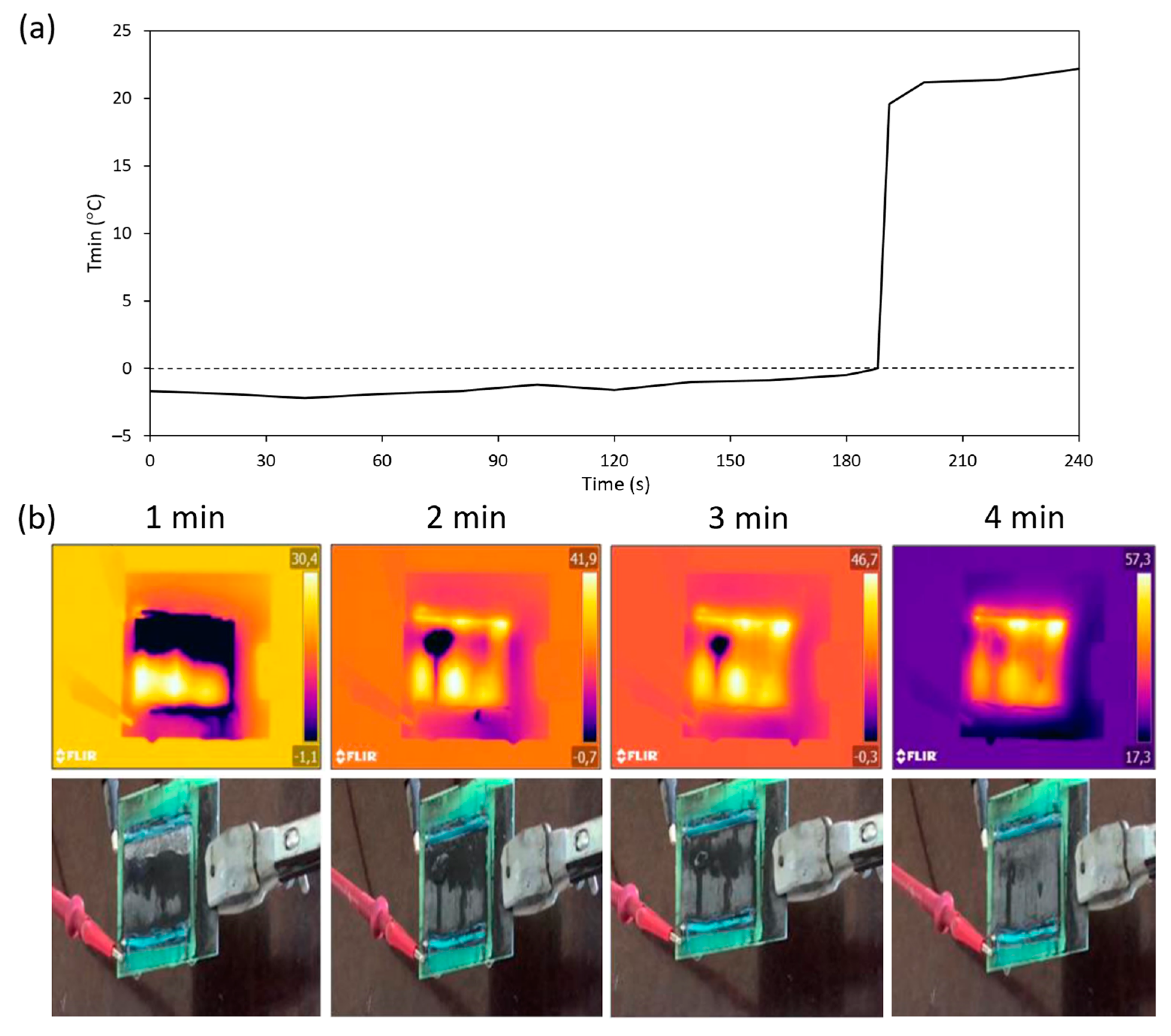Electrothermally Activated CNT/GNP-Doped Anti-icing and De-Icing Systems: A Comparison Study of 3D Printed Circuits versus Coatings
Abstract
:Featured Application
Abstract
1. Introduction
2. Materials and Methods
2.1. Materials
2.2. Manufacturing of Nanocomposite Specimens
2.3. Characterization
2.3.1. Morphological Characterization
2.3.2. Electrical and Electrothermal Characterization
2.3.3. De-Icing Test
3. Results
3.1. Electrical and Electrothermal Characterization
3.2. De-Icing Test
4. Conclusions
Author Contributions
Funding
Data Availability Statement
Conflicts of Interest
References
- Villeneuve, E.; Ghinet, S.; Volat, C. Experimental Study of a Piezoelectric De-Icing SystemImplemented to Rotorcraft Blades. Appl. Sci. 2021, 11, 9869. [Google Scholar] [CrossRef]
- Bhutta, M.S.; Xuebang, T.; Akram, S.; Yidong, C.; Ren, X.; Fasehullah, M.; Rasool, G.; Nazir, M.T. Development of novel hybrid 2D-3D graphene oxide diamond micro composite polyimide films to ameliorate electrical & thermal conduction. J. Ind. Eng. Chem. 2022, 114, 108–114. [Google Scholar]
- Kenzhebayeva, A.; Bakbolat, B.; Sultanov, F.; Daulbayev, C.; Mansurov, Z. A Mini-Review on Recent Developments in Anti-icing Methods. Polymers 2021, 13, 4149. [Google Scholar] [CrossRef] [PubMed]
- Redondo, O.; Prolongo, S.G.; Campo, M.; Sbarufatti, C.; Giglio, M. Anti-icing and De-Icing Coatings Based Joule’s Heating of Graphene Nanoplatelets. Compos. Sci. Technol. 2018, 164, 65–73. [Google Scholar] [CrossRef]
- Mohseni, M.; Amirfazli, A. A Novel Electro-Thermal Anti-icing System for Fiber-Reinforced Polymer Composite Airfoils. Cold Reg. Sci. Technol. 2013, 87, 47–58. [Google Scholar] [CrossRef]
- Yong, S.M.; Lee, S.J.; Park, J.; Hong, J.; Jung, J.H.; Kim, Y. Fiber-Reinforced Plastic Material with de-Icing Capability for Radome Application. Mater. Lett. 2021, 284, 128943. [Google Scholar] [CrossRef]
- Cortés, A.; Romate, X.F.S.; Jiméjez-Suárez, A.; Campo, M.; Prolongo, M.G.; Ureña, A.; Prolongo, S.G. 3D Printed Anti-icing and De-Icing System Based on CNT / GNP Doped Epoxy Composites with Self-Curing and Structural Health Monitoring Capabilities. Smart Mater. Struct. 2021, 30, 025016. [Google Scholar] [CrossRef]
- Cortés, A.; Jiménez-Suárez, A.; Campo, M.; Ureña, A.; Prolongo, S.G. Assessment of Manufacturing Parameters for New 3D-Printed Heating Circuits Based on CNT-Doped Nanocomposites Processed by UV-Assisted Direct Write. Appl. Sci. 2021, 11, 7534. [Google Scholar] [CrossRef]
- Jiménez-Suárez, A.; Campo, M.; Sánchez, M.; Romón, C.; Ureña, A. Dispersion of Carbon Nanofibres in a Low Viscosity Resin by Calendering Process to Manufacture Multiscale Composites by VARIM. Compos. Part B 2012, 43, 3104–3113. [Google Scholar] [CrossRef]
- Cortés, A.; Jiménez-Suárez, A.; Campo, M.; Ureña, A.; Prolongo, S.G. 3D Printed Epoxy-CNTs/GNPs Conductive Inks with Application in Anti-icing and De-Icing Systems. Eur. Polym. J. 2020, 141, 110090. [Google Scholar] [CrossRef]



| Specimen | Width (mm) | Thickness (µm) | Cross-Sectional Area (mm2) | Volume (mm3) |
|---|---|---|---|---|
| 3D-printed ribbons | 1.14 ± 0.07 | 439 ± 41 | 0.32 ± 0.04 | 16.43 ± 2.04 |
| 3D-printed circuit | 13.69 ± 0.07 | 439 ± 41 | 3.88 ± 0.04 | 197.13 ± 24.54 |
| Coating | 52.79 ± 1.06 | 188 ± 22 | 9.93 ± 1.24 | 496.56 ± 61.82 |
Publisher’s Note: MDPI stays neutral with regard to jurisdictional claims in published maps and institutional affiliations. |
© 2022 by the authors. Licensee MDPI, Basel, Switzerland. This article is an open access article distributed under the terms and conditions of the Creative Commons Attribution (CC BY) license (https://creativecommons.org/licenses/by/4.0/).
Share and Cite
Cortés, A.; Jiménez-Suárez, A.; Ureña, A.; Prolongo, S.G.; Campo, M. Electrothermally Activated CNT/GNP-Doped Anti-icing and De-Icing Systems: A Comparison Study of 3D Printed Circuits versus Coatings. Appl. Sci. 2022, 12, 8875. https://doi.org/10.3390/app12178875
Cortés A, Jiménez-Suárez A, Ureña A, Prolongo SG, Campo M. Electrothermally Activated CNT/GNP-Doped Anti-icing and De-Icing Systems: A Comparison Study of 3D Printed Circuits versus Coatings. Applied Sciences. 2022; 12(17):8875. https://doi.org/10.3390/app12178875
Chicago/Turabian StyleCortés, Alejandro, Alberto Jiménez-Suárez, Alejandro Ureña, Silvia G. Prolongo, and Mónica Campo. 2022. "Electrothermally Activated CNT/GNP-Doped Anti-icing and De-Icing Systems: A Comparison Study of 3D Printed Circuits versus Coatings" Applied Sciences 12, no. 17: 8875. https://doi.org/10.3390/app12178875
APA StyleCortés, A., Jiménez-Suárez, A., Ureña, A., Prolongo, S. G., & Campo, M. (2022). Electrothermally Activated CNT/GNP-Doped Anti-icing and De-Icing Systems: A Comparison Study of 3D Printed Circuits versus Coatings. Applied Sciences, 12(17), 8875. https://doi.org/10.3390/app12178875










